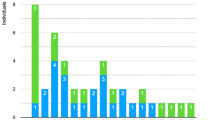Abstract
Introduction
One of the goals of cranial vault expansion performed in patients with craniosynostosis (CS) is to reduce the harmful effects associated with elevated intracranial pressure (ICP). Until now, clear guidelines on when cranial vault expansion should take place have not been established except in unacceptable cosmetic deformities.
Materials and methods
This paper illustrates the potential benefit of ICP monitoring in determining the time of surgery. The ICP of six patients (ranging from 7 months to 8 years) was measured before and after surgery. For the first time, we regulated end-tidal carbon dioxide, the position and movements, the level of sedation and the monitoring site of our patients under anesthesia to report accurate ICP readings.
Results
The mean pre- and postoperative ICPs were 14.7 and 4.2 mmHg, respectively. Pressure sensor was placed through a burr hole under general anesthesia and remained through all stages of recording. Though ICP monitoring has been reported before, the physiological fluctuations of ICP and patient’s condition affected results. Under our ICP monitoring protocol, the six-patient study represents a suggestion to standardize ICP measurements under certain conditions in order to improve the reproducibility of ICP monitoring and therefore establish the need for optimal timing of cranial vault expansion in pediatrics.
Conclusion
Although we cannot clearly define the indications and establish normal pediatric ICP values from the result of this study because of the small number of cases and some other limitations, this is a new approach to define ICP increase as a potential indication for surgery in CS.



Similar content being viewed by others
References
Gault DT, Renier D, Marchac D, Ackland FM, Jones BM (1990) Intracranial volume in children with craniosynostosis. J Craniofac Surg 1:1–3
Gault DT, Renier D, Marchac D, Jones BM (1992) Intracranial pressure and intracranial volume in children with craniosynostosis. Plast Reconstr Surg 90:377–381
Eide PK, Helseth E, Due-Tonnessen B, Lundar T (2002) Assessment of continuous intracranial pressure recordings in childhood craniosynostosis. Pediatr Neurosurg 37:310–320
Thompson DN, Harkness W, Jones B, Gonsalez S, Andar U, Hayward R (1995) Subdural intracranial pressure monitoring in craniosynostosis: its role in surgical management. Childs Nerv Syst 11:269–275
Minns RA (1984) Intracranial pressure monitoring. Arch Dis Child 59:486–488
Eide PK, Helseth E, Due-Tonnessen B, Lundar T (2001) Changes in intracranial pressure after calvarial expansion surgery in children with slit ventricle syndrome. Pediatr Neurosurg 35:195–204
Gambardella G, Zaccone C, Cardia E, Tomasello F (1993) Intracranial pressure monitoring in children: comparison of external ventricular device with the fiberoptic system. Childs Nerv Syst 9:470–473
Pople IK, Muhlbauer MS, Sanford RA, Kirk E (1995) Results and complications of intracranial pressure monitoring in 303 children. Pediatr Neurosurg 23:64–67
Inagaki T, Kyutoku S, Seno T, Kawaguchi T, Yamahara T, Oshige H, Yamanouchi Y, Kawamoto K (2007) The intracranial pressure of the patients with mild form of craniosynostosis. Childs Nerv Syst 23:1455–1459
Czosnyka M, Pickard JD (2004) Monitoring and interpretation of intracranial pressure. J Neurol Neurosurg Psychiatry 75:813–821
Wiegand C, Richards P (2007) Measurement of intracranial pressure in children: a critical review of current methods. Dev Med Child Neurol 49:935–941
Desch LW (2001) Longitudinal stability of visual evoked potentials in children and adolescents with hydrocephalus. Dev Med Child Neurol 43:113–117
Tamburrini G, Caldarelli M, Massimi L, Santini P, Di Rocco C (2005) Intracranial pressure monitoring in children with single suture and complex craniosynostosis: a review. Childs Nerv Syst 21:913–921
Eddy VA, Vitsky JL, Rutherford EJ, Morris JA Jr (1995) Aggressive use of ICP monitoring is safe and alters patient care. Am Surg 61:24–29
Bartels MC, Vaandrager JM, de Jong TH, Simonsz HJ (2004) Visual loss in syndromic craniosynostosis with papilledema but without other symptoms of intracranial hypertension. J Craniofac Surg 15:1019–1022, discussion 1023–1014
Stavrou P, Sgouros S, Willshaw HE, Goldin JH, Hockley AD, Wake MJ (1997) Visual failure caused by raised intracranial pressure in craniosynostosis. Childs Nerv Syst 13:64–67
Renier D, Sainte-Rose C, Marchac D, Hirsch JF (1982) Intracranial pressure in craniostenosis. J Neurosurg 57:370–377
Acknowledgement
We thank Dr. Kostadin Karagiozov and David Huang for his guidance and gratefully acknowledge the radiological technologists, nurses, and staff of Departments of Neurosurgery, Tokyo Women’s Medical University in preparing this paper.
Declaration of Funding Source
This study was supported by research funds of Department of Neurosurgery, Tokyo Women’s Medical University.
Conflict of Interest Disclosure
The authors have no personal financial or institutional interest in any of the materials or devices described in this article.
Author information
Authors and Affiliations
Corresponding author
Rights and permissions
About this article
Cite this article
Yokote, A., Aihara, Y., Eguchi, S. et al. Intraoperative pre- and post-craniofacial reconstruction intracranial pressure (ICP) monitoring in children with craniosynostosis. Childs Nerv Syst 29, 1363–1367 (2013). https://doi.org/10.1007/s00381-013-2049-0
Received:
Accepted:
Published:
Issue Date:
DOI: https://doi.org/10.1007/s00381-013-2049-0




